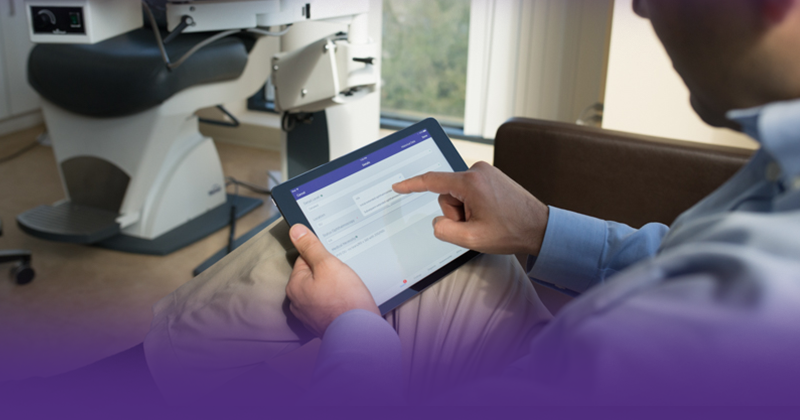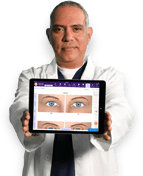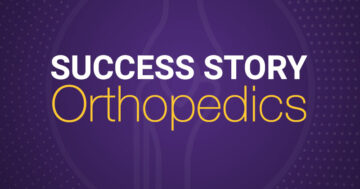Ophthalmology EHR Software is Already More Than Paper on a Screen

“The future is already here — it’s just not very evenly distributed.” — William Gibson, 1993
Many ophthalmologists and their staff frequently complain that electronic health records (EHR) systems have yet to fulfill many of their promises. This is especially true in large centers that have implemented an EHR system that isn’t created with specialists in mind. Among ophthalmologists who use an EHR system, only 25 percent report that their ophthalmology EHR software made it easier to provide quality care, whereas a disheartening 35 percent report the opposite.1
The most commonly raised issues with EHR systems are unsatisfactory interoperability, workflows, user interfaces, functionality outside recording data, and adaptation to clinicians’ unique usage patterns—much of which is due to a lack of input from practicing clinicians.2,3 In an extreme example, one clinician (ostensibly dissatisfied with their current EHR system) reported that merely recording a patient’s flu shot in their EHR system took a whopping 32 clicks!4 Such issues incur “cognitive burden,” which makes users prone to errors and burnout. The most disheartening problem with outdated or poorly designed EHR systems is that clinicians spend less time with patients.
However, some, but not all, EHR systems have already moved beyond “paper on a screen” status. Cutting-edge, specialty-specific EHR systems on the market today, such as Modernizing Medicine®’s EMA®, can empower ophthalmologists to help improve their practice and save time through actionable, data-driven insights. Moreover, practicing ophthalmologists and EHR vendors have distinct responsibilities and must actively collaborate to help make digital healthcare work.
What the Top Ophthalmology EHR Systems Already Do
Leading EHR systems have already resolved the egregious design flaws mentioned earlier and utilize more user-friendly technologies such as tablets with touch-based interfaces, speech recognition, and dictation. Moreover, leading EHRs utilize cloud technology, allowing ophthalmologists and staff to work across multiple devices and locations5
Leading ophthalmology EHR systems do even more: they learn from and adapt to individual unique practice styles and automate tedious or repetitive tasks. They show the right content at the right time, helping to streamline documentation. For example, EMA automatically populates an individual clinician’s most commonly used diagnoses or treatments at the top of drop-down lists. EMA also offers a level of further customization enabling clinicians to create a custom workflow for common procedures. For example, if an ophthalmologist regularly performs preoperative cataract screening, they can create a custom workflow in EMA to document their discussion with the patient, the decision made, and any surgery planning.
Perhaps the entire point of adopting EHR systems is to harness the power of data. The best EHR systems don’t just collect data, they present it in meaningful ways, empowering ophthalmologists to help make more informed decisions. For example, with EMA, practices have access to built-in analytics that show summary statistics and metrics about their practice benchmarked against data from CMS. Practices can also run queries that give them customized views into their practices. One of our ophthalmology clients used analytics to determine how many of his glaucoma patients had missed evaluations in the last six months and got them to come in for a follow-up. The best EHR systems empower us to use our own data to identify gaps in our practice and make improvements.
Ophthalmologists and EHR Vendors: Why Collaboration is Essential
Ophthalmologists and EHR vendors must acknowledge their distinct responsibilities in co-creating the future. Good design is essential, but it isn’t enough. At a minimum, software developers and UI/UX designers must actively collaborate with ophthalmologists through advisory boards comprised of practicing ophthalmologists.6
Leading EHR system vendors, like Modernizing Medicine, have designed an ophthalmology-specific EHR system from the ground up with continuous input from practicing ophthalmologists serving various subspecialties.5,6 Modernizing Medicine was founded on the principle that it is far easier to teach a physician to code than to teach a software developer to practice medicine. That’s why it employs practicing ophthalmologists who can also code. This infuses the solution with expert knowledge.
When Modernizing Medicine receives a customer request or concern, these physicians can look at the issue from the standpoint of someone who understands an ophthalmologist’s workflow and style, and work alongside developers to improve the system. For example, whenever a drug or procedure receives FDA approval, vendors must update their EHR system. However, these are also opportunities to delight customers. When a new intravitreal injection was approved for ophthalmology, Dr. Gallogly, a staff physician at Modernizing Medicine, was at his keyboard putting together a plan and procedure note for documentation within the company’s ophthalmology EHR system, EMA — even before customers requested it.
Having physician-coders on staff is even more critical to meet the needs of subspecialties. For example, when an ocular oncology specialty clinic requested software updates to meet their distinct needs, Dr. Gallogly visited them on site to conduct an assessment, which led to the development of a new ocular oncology exam set and plan set.
Post-release, vendors must actively and consistently solicit input and feedback both remotely and on site. In particular, vendors should assist ophthalmologists who are closing visits outside regular hours, and not using their system to its fullest potential. User conferences are another opportunity for vendors to collaborate with customers, provide training and build goodwill. However, all of these activities are uncommon in the specialty-specific EHR industry, which has led to frustration with existing systems.
The Proactive Role of Ophthalmologists
Meanwhile, to ensure that EHR system vendors meet their needs, ophthalmologists must be involved from the start of development. Post-implementation, ophthalmologists must proactively provide constructive feedback and take opportunities to engage with vendors. In addition, doctors must ensure that staff are properly trained when a new system is implemented and when updates are made, as this is reported to be a key predictor of success. Well-trained physicians and staff can give constructive feedback, which can translate into time-saving software improvements.
Beyond training, ophthalmologists must fully use their EHR systems to help bring efficiency to their practice. Leading ophthalmic EHR systems, like EMA, help automate tedious clerical tasks like submitting data for Merit-based Performance System (MIPS) compliance. When ophthalmologists input data into EMA, the system automatically asks questions intended to help a physician with MIPS compliance. Some of the best EHR systems can help manage office flow, which may reveal areas where the practice could become more efficient. For example, by using his own practice workflow in EMA, Dr. Gallogly found that his own practice got bogged down in photography every Tuesday. Once he identified the problem, the solution was easy.
Although EHR systems have been characterized as, “a race car prototype we have yet to learn to drive beyond first gear,”2 some EHR systems, and the enterprising ophthalmologists who use them, are well past the prototype stage, leaving others behind. Nevertheless, to create the future of medicine, we must demand more from our EHR systems and vendors, and vendors must actively engage the ophthalmology community. This will help create a virtuous circle of improvements in both patient care and EHR systems themselves.

See how you can achieve a healthier practice with ModMed® Ophthalmology

Michael B. Rivers, MD
Director of Ophthalmology
Dr. Michael B. Rivers is the Director Ophthalmology. In this role, he helps Modernizing Medicine evolve the ophthalmology platform by combining his years of experience as a board-certified ophthalmologist and retina surgeon with his expertise implementing and using the EMA® EHR system at the Retina Group of Washington (RGW). Michael speaks with physician users, listens to their needs and communicates them to the development, customer success and other teams at Modernizing Medicine.
2Adoption of Electronic Health Records and Perceptions of Financial and Clinical Outcomes Among Ophthalmologists in the United States. JAMA Ophthalmol. 2018;136(2):164-170.
3Changes in Burnout and Satisfaction With Work-Life Balance in Physicians and the General US Working Population Between 2011 and 2014. Mayo Clin Proc. 2015;90(12):1600-1613.
4Steenhuysen J. Counting the costs: U.S. hospitals feeling the pain of physician… Reuters. https://www.reuters.com/article/us-usa-healthcare-burnout-idUSKBN1DL0EX. Published 2017. Updated 2017-11-21. Accessed 15 December, 2018
5Shanafelt TD, Dyrbye LN, Sinsky C, et al. Relationship Between Clerical Burden and Characteristics of the Electronic Environment With Physician Burnout and Professional Satisfaction. Mayo Clin Proc. 2016;91(7):836-848.
6Ariely D, Lanier WL. Disturbing Trends in Physician Burnout and Satisfaction With Work-Life Balance: Dealing With Malady Among the Nation’s Healers. Mayo Clin Proc. 2015;90(12):1593-1596.
7Arndt BG, Beasley JW, Watkinson MD, et al. Tethered to the EHR: Primary Care Physician Workload Assessment Using EHR Event Log Data and Time-Motion Observations. Ann Fam Med. 2017;15(5):419-426.
8Chiang MF, Read-Brown S, Tu DC, et al. Evaluation of electronic health record implementation in ophthalmology at an academic medical center (an American Ophthalmological Society thesis). Trans Am Ophthalmol Soc. 2013;111:70-92.
9Chiang MF, Boland MV, Brewer A, et al. Special requirements for electronic health record systems in ophthalmology. Ophthalmology. 2011;118(8):1681-1687.
10Silverman H, Ho YX, Kaib S, et al. A novel approach to supporting relationship-centered care through electronic health record ergonomic training in preclerkship medical education. Acad Med. 2014;89(9):1230-1234.







